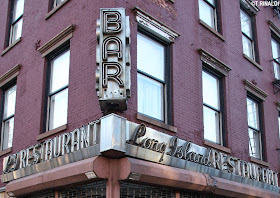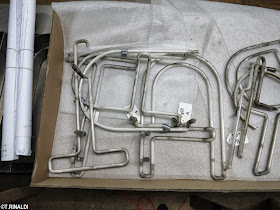The sketches began as simple silhouettes of the more distinctive old swing signs still hanging over New York sidewalks. (T. Rinaldi)
My idea was to create a sort of HABS/HAER-type documentation of these signs as significant works of vernacular design, before they disappear. I also thought that these little sketches might look good illustrating the endpapers of the neon book. Short of traipsing all over town with my step ladder and measuring tape, I made these in CAD by tracing perspective-corrected photos. So, if not quite accurate to a 32nd of an inch, these sketches at least provide something of a record beyond the photos in the book.
The drawings never made it into the book, so - here they are, out of the depths for your enjoyment and some measure of posterity, in two installments. Stay tuned for Part II next week.
I have attempted to organize these by business type. Let's start at the bars:
FROM TOP: Collins Bar, 735 8th Ave., Manhattan, made c1930; Boulevard Tavern, 579 Meeker Ave., Brooklyn, made c1935; Farrell’s Bar & Grill, 215 Prospect Park West, Brooklyn, made c. 1935*; Fedora Restaurant, 239 W4th Street, Manhattan, made c1946; Minetta Tavern, 113 Macdougal St., Manhattan, made c1950; Old Town Bar, 45 E18th St., Manhattan, made 1937; White Horse Tavern, 567 Hudson St., Manhattan, made 1947 by the Allen Sign Co.; Rudy's Bar & Grill, 627 9th Ave., Manhattan, made 1937; Rocco Restaurant, 181 Thompson St., Manhattan, made 1934.
Still Thirsty? We can always pick up more at these fine establishments:
FROM TOP: Casa Oliveira Wines and Liquors, 98 7th Ave. South, Manhattan, made 1935; Golden Rule Liquors, 457 Hudson St., Manhattan, made in 1934 possibly Neon Sign & Svc. Co.; Manley’s Liquors, 35 8th Ave., Manhattan, made c1934*; Mom’s Liquor Store, 2045 Richmond Terrace, Port Richmond, Staten Island, made c. 1935; Sterling Wines Liquors, 117 Smith St., Brooklyn, made c. 1935.
Phew! So much for the drinking establishments. Let's go nurse that hangover with a little typography appreciation. As previously noted on this blog, sign painters really enjoyed juxtaposing scripts with block letters. I enjoy it too:
FROM TOP: Catania’s Shoe Shop, 3015 Westchester Ave., Bronx, made c1945 by Globe Neon; Garry Jewlers, 474 5th Ave., Brooklyn, made c1961*; Long Island Restaurant, 108 Atlantic Ave., Brooklyn, made c1953*; Morscher’s Pork Store, 5844 Catalpa Ave., Ridgewood, Queens, made c1950 (RIP); Patsy’s Restaurant, 236 W56th Street, Manhattan, made 1954 by Serota Sign Corp.; Smith’s Bar, 701 8th Ave., Manhattan, made 1954 by DaNite Sign Co.
That's it for Part I. Stand by for more next week.....
As always, feel free to contact me with any questions.
IN OTHER NEON NEWS:
That's it for Part I. Stand by for more next week.....
As always, feel free to contact me with any questions.
IN OTHER NEON NEWS:
Speaking of cool elevation drawings of old neon signs - you can help restore the old neon marquee of the former Grauman's Chinese Theatre in LA, now in the collection of the Museum of Neon Art.
From James and Karla Murray, a depressing then-and-now of the late great McHale's bar in Hell's Kitchen.
At Shorpy, an inspirational if vanished scene from Southington, CT.
Not nice (or entirely accurate) but worth a read: some anti-neon propaganda from the LED people.
Over at Project Neon, a nice write-up on the neon-festoond Kiosk of SoHo, apparently not long for this world.
Not nice (or entirely accurate) but worth a read: some anti-neon propaganda from the LED people.
Over at Project Neon, a nice write-up on the neon-festoond Kiosk of SoHo, apparently not long for this world.










































